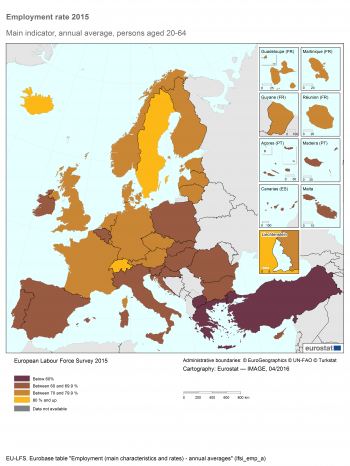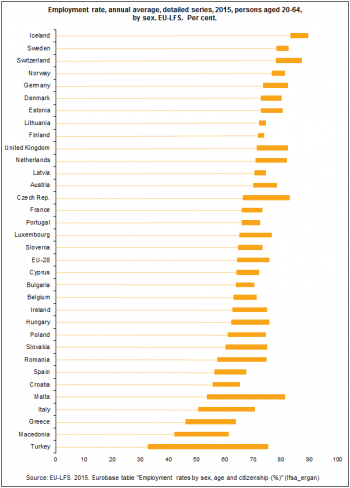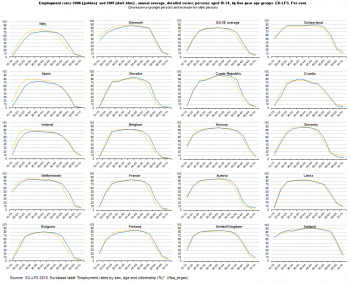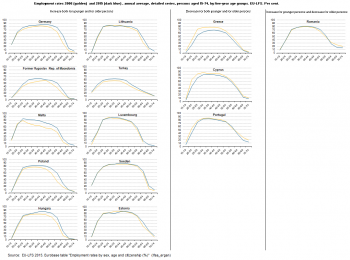Archive:Employment rates – annual statistics
The employment rate gives information on the share of the adult population that has a paid job (or, more technically, is an employed person). The pay can be in cash or in kind, and the job can be as an employee, as self-employed, or as a family worker. As a paid job in most cases is the main source for determining the living standard of people, the employment rate gives an indication on the socio-economic conditions of individuals in a country. It also describes to what extent the human resources of a country are utilised for economic purposes, and thereby also provides key macroeconomic information.
Most of the EU Member States have set national targets for the employment rate in 2020, as part of the EU 2020 strategy. This article will compare for each Member State the value of the employment rate in 2015 with the national target, alongside with a range of other breakdowns of the detailed series of the employment rate.
Please note that Eurostat provides two sets of indicators linked to the annual employment rate, which serve different purposes and which in some cases differ from each other:
1) The main indicators, which are seasonally adjusted. They include the headline indicators under the EU2020 Strategy and are consequently used for monitoring the EU2020 targets (at EU and national levels). They have only a few breakdowns and normally refers to the age group 20-64. Please also note that for France the main indicators exclude overseas departments.
2) The detailed results, which are not seasonally adjusted. They have a large number of breakdowns and can therefore be used for more detailed analysis. These include the French overseas departments.
This article presents annual results for some indicators from the two sets described here above.
Main statistical findings

As shown in Figure 1, notable differences could be found among countries in 2015 as regards the employment rate, with a spread from 51.9 % to 86.5 %. Some geographical patterns, at least for the low and middle ranking countries, clearly appeared. Greece was the Member State recording the lowest value, with an employment rate of 54.9%. With the former Yugoslav Republic of Macedonia and Turkey, it forms the group of countries having an employment rate lower than 60%. Employment rates between 60 and up to 70 % predominantly appeared in the southern and eastern Member States, but also in Ireland and Belgium. Germany, France and the United Kingdom were part of the middle-high group (70 - 80 per cent), as well as most northern countries. Finally, Sweden recorded the highest employment rate in the EU, i.e. 80.5%. With Iceland and Switzerland, it is the only country with an employment rate at 80% or over.
Employment rate targets at EU and national levels
The target of the Europe 2020 strategy is to have an employment rate of at least 75 % for persons aged 20-64 in the EU by 2020. This objective has been translated into national targets in order to reflect the situation and the possibilities of each Member State to contribute to the common goal. The national targets vary considerably across countries, stretching from 62.9% in Croatia to 80.0% in Denmark, the Netherlands and Sweden.
When comparing the evolution of the employment rate in the Member States with their national targets (see Figure 2), we see that four Member States reached their national targets several years ago, but had again fallen below it in 2015 (Croatia, Cyprus, Ireland, and Latvia). Another four Member States reached or exceeded their national targets in 2015 (Germany, Estonia, Lithuania, and Sweden). It is worth noting that Sweden while being one of the countries with the highest national target achieved it five years before the schedule.
Goal attainment levels

Click for animation
Source: Eurostat (lfsi_emp_a) and EU2020 national targets
From 2002 to 2015 the employment rate in the EU-28 increased by 3.4 percentage points, from 66.7% to 70.1%. Twenty-two Member States recorded an increase in their employment rate during this period. The exceptions are Greece, Spain, Ireland, Cyprus, Portugal and Denmark. The increase was higher than 10 percentage points in Bulgaria, Malta and Poland.
Looking in more details at the trend between 2002 and 2015 in Figure 2, the boom years before 2008 and the crisis afterwards are visible at the EU level, but not very marked. The almost flat line for the EU evolution of the employment rate results from different situations in the individual Member States.
Among the 22 Member States with an increased employment rate, the evolution since 2002 is relatively stable for 11 Member States, not showing any large increase before 2008 nor any large drop afterwards. This group includes, in addition to Slovakia and Slovenia, four large Member States (France, Italy, Romania and the United Kingdom), as well as two Nordic Member States (Sweden and Finland) and the Benelux countries. The three Baltic States (Estonia, Latvia and Lithuania) all show a massive rise, then a massive drop, followed by a gradual but strong recovery. Bulgaria, having a massive rise in the employment rate followed by a relatively stable period afterwards, cannot be classified with any other Member State. Six Member States show growth throughout the whole period under consideration; some of them even with very marked improvement: this clear growth cluster consists of Germany, Austria, the Czech Republic, Hungary, Poland, in addition to Malta.
Five of the six Member States with a drop in the employment rate between 2002 and 2015 have all encountered a marked drop during the crisis years (especially Greece, Ireland and Spain but also Cyprus and Portugal). In Denmark, there is also a downward trend but much smaller and from a markedly more favourable starting point.
Employment rate by sex

A substantial number of countries have a large untapped workforce among women. Figure 3 shows the gender gap, as well as the employment rate levels of men and women in each country. The left side of the bars show the employment rate of women, and the right side of the bars show the employment rate of men. That means the longer the bar, the larger the gender gap. The countries are ranked on the employment rate of women, which means the higher up in the chart, the higher the employment rate for women in the country. The lower part of the chart, meaning low employment rates for women, is clearly dominated by southern and central-eastern countries. Long bars, meaning large gender gaps, are found in Greece, Italy, Malta, Romania, the Czech Republic, Turkey and FYR of Macedonia, . Short bars, close to gender equality, correspond to Finland and Lithuania. The highest employment rates for women are in Sweden, Germany, Denmark and Iceland.
Employment rate by age


In addition to increasing the employment rate of women, a clear policy target in the European Union is also to rise the employment rate of older people. Under the hypothesis that the employment rate of younger people is stable, it should increase the total employment rate.
From 2006 to 2015, the employment rate of people aged 55-74 rose in the EU-28 to reach 53.3% in 2015. An increase is recorded in 24 Members States. The exceptions are Greece, Cyprus, Portugal and Romania.
As shown in Figure 3.2, only eight countries show an increased employment rate for both the younger (here defined as persons aged 15-34) and the older (55-74) people, with Germany being the country with the largest change. For the majority of countries (19 countries in total, in Figure 3.1), the increase in the employment rate for the older persons is associated with a decrease of the employment rate for the younger persons. The effect, a parallel shift of the graph lines of 2006 and 2015, is most visible in Italy, Spain, Ireland and the Netherlands, but is also to some extent existing in all other countries in Figure 3.1. The countries are ranked on the absolute effect of the decrease for younger people plus the increase of older people (Italy as the first, Spain as the second, Iceland as the last).
Two other groups of countries can be found in Figure 3.2, a trio (Greece, Cyprus and Portugal) which has an overall downward trend, and Romania on its own, which shows a marginal increase for the younger persons while having a decrease for older persons.
Data sources and availability
Source: the European Union Labour Force Survey (EU-LFS) is a large sample, quarterly survey providing results for the population in private households in the EU, EFTA and the candidate countries. Conscripts in military or community service are not included in the results.
Reference period: Yearly results are obtained as averages of the four quarters in the year.
Coverage: France: Since the first quarter of 2014 the overseas departments of Guadeloupe, Martinique, Guyane, and La Réunion are covered, in addition to the metropolitan territory. Overseas department are included in the results of the detailed series, but not in the results of the main indicator. Cyprus: The survey covers only the areas of Cyprus controlled by the Government of the Republic of Cyprus.
Country codes: Belgium (BE), Bulgaria (BG), the Czech Republic (CZ), Denmark (DK), Germany (DE), Estonia (EE), Ireland (IE), Greece (EL), Spain (ES), France (FR), Croatia (HR), Italy (IT), Cyprus (CY), Latvia (LV), Lithuania (LT), Luxembourg (LU), Hungary (HU), Malta (MT), the Netherlands (NL), Austria (AT), Poland (PL), Portugal (PT), Romania (RO), Slovenia (SI), Slovakia (SK), Finland (FI), Sweden (SE), the United Kingdom (UK), Iceland (IS), Norway (NO), Switzerland (CH), the former Yugoslav Republic of Macedonia (MK), Turkey (TR). The abbreviation MK used for the former Yugoslav Republic of Macedonia is a provisional code which does not prejudice in any way the definitive nomenclature for this country, which will be agreed following the conclusion of negotiations currently taking place on this subject at the United Nations.
European aggregates: EU refers to the sum of EU-28 Member States and EA to the sum of the 19 euro area Member States. If data are unavailable for a country, the calculation of the corresponding aggregates takes into account the data for the same country for the most recent period available. Such cases are indicated.
Definitions: The concepts and definitions used in the survey follow the guidelines of the International Labour Organisation. Employment covers persons aged 15 years and over (16 and over in Spain, Italy and the United Kingdom, 15-74 years in Estonia, Latvia, Hungary, Finland, Sweden, Norway and Denmark, and 16-74 years in Iceland), living in private households, who during the reference week performed work, even for just one hour, for pay, profit or family gain, or were not at work but had a job or business from which they were temporarily absent, for example because of illness, holidays, industrial dispute or education and training. The LFS employment concept differs from national accounts domestic employment, as the latter sets no limit on age or type of household, and also includes the non-resident population contributing to GDP and conscripts in military or community service. Definitions of indicators reported in this publication are available on the EU-LFS Statistics Explained website: EU Labour Force Survey (Statistics Explained)
Context
The article on Labour market and Labour force survey (LFS) statistics presents a series of other annual results of the LFS. For deeper insight into the labour market, this article should also be read together with Unemployment statistics and Underemployment and potential additional labour force statistics. The main source for the employment rate calculation is the labour force survey (LFS). The results from the survey currently cover all European Union member states, the EFTA member states of Iceland, Norway, Switzerland, as well as the candidate countries Turkey and the Former Yugoslav Republic of Macedonia. The survey is based on the same target populations and uses the same definitions in all countries, which means that the results are comparable between the countries. Five different articles on detailed technical and methodological information is linked from the overview page EU labour force survey.
The EU-LFS is the largest European household sample survey providing quarterly and annual results on labour participation of people aged 15 and over as well as on persons outside the labour force. It covers residents in private households. The EU-LFS is an important source of information about the situation and trends in the EU labour market.
Each quarter around 1.8 million interviews are conducted throughout the participating countries to obtain statistical information for some 100 variables. Due to the diversity of information and the large sample size the EU-LFS is also an important source for other European statistics like Education statistics or Regional statistics.
See also
Further Eurostat information
Publications
- Labour market statistics - Pocketbook - 2011 edition
- European Union Labour force survey - selection of electronic articles (Statistics Explained)
Main tables
Database
Dedicated section
Methodology / Metadata
Notes